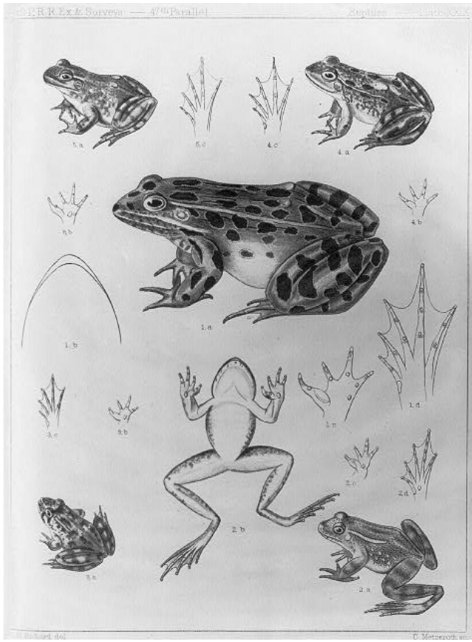Teach This Poem, though developed with a classroom in mind, can be easily adapted for remote-learning, hybrid-learning models, or in-person classes. Please see our suggestions for how to adapt this lesson for remote or blended learning. We have also noted suggestions when applicable and will continue to add to these suggestions online.
Look at these drawings of a frog titled “[Reptiles]” from the Library of Congress.
The following activities and questions are designed to help your students use their noticing skills to move through the poem and develop their thinking about its meaning with confidence, using what they’ve noticed as evidence for their interpretations. Read more about the framework upon which these activities are based.
- Warm-up: Look closely at these drawings of a frog. What do you notice? Look again. What else do you see?
- Before Reading the Poem: Watch this short, animated, silent video about the poet Matsuo Basho. What do you notice about the animation? Which images stand out and why?
- Reading the Poem: Now, silently read the poem “[An ancient pond!]” by Matsuo Basho. What do you notice about the poem? Note any words or phrases that stand out to you or any questions you might have.
- Listening to the Poem: (Enlist two volunteers to read the poem aloud.) Listen as the poem is read aloud twice, and write down any additional words and phrases that stand out to you.
- Small-group Discussion: Share what you noticed in the poem with a small group of students. Based on the details you just shared with your small group and the resources from the beginning of class, how does the frog come alive in this poem? Read this definition of haiku. What does this information make you think about the poem?
- Whole-class Discussion: (Teachers, split your class into groups and assign each group a line to prepare for a mini-debate discussion.) With your group, read your assigned line. What words and phrases stand out in this line? What is unique about the language in this line? Why? When you are ready, debate why your assigned line is the most important line in the poem. How might the poem be different without your assigned line?
- Extension for Grades 7-8: Read more about Matsuo Basho, including several other haikus. Over the course of the week, write a haiku each day about something in your day or something meaningful to you. At the end of the week, choose one of your haikus and share with your classmates. Discuss how you felt writing and exploring this form of poetry. What was easy? What was difficult?
- Extension for Grades 9-12: “[An ancient pond!]” is a famous haiku that has been translated for hundreds of years. Read thirty-two different English translations of the poem. Choose one and prepare notes for how this translation is meaningful. Share your notes and thoughts with your classmates in a Socratic seminar. (Teachers, you may wish to have printed copies of the poem for the discussion.)
“Submit to nature, return to nature,” wrote the seventeenth-century Japanese poet Matsuo Basho, thus capturing the beauty and simplicity of the haiku—a seventeen-syllable poem traditionally depicting a fleeting moment of a given season. The same can be said of the haiku’s more visual cousin, the haiga, which unites a haiku poem, written in calligraphy, with a simple painting. Read more about the connection between haiku and haiga.
This week’s glossary term is renga, a form consisting of alternating tercets and couplets written by multiple collaborating poets. Read more.

